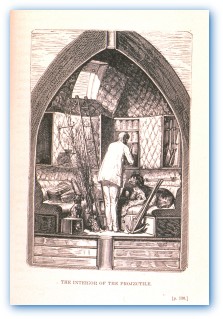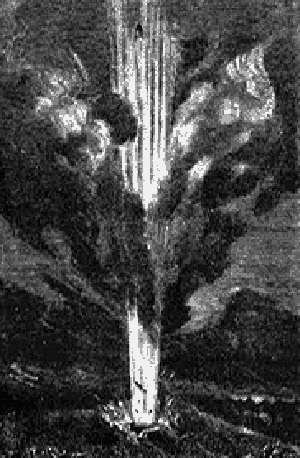From the Earth to the Moon

Inside the Projectile.

Firing of the Columbiad.
From the Earth to the Moon is a novel by Jules Verne in which a capsule containing three men and two dogs is blasted out of an immense cannon, the Columbiad, toward the Moon. From the Earth to the Moon1 (1865) and its sequel Around the Moon2 (1870) are packed with technical details some of which, it was realized at the time of the Apollo 8 and 11 missions, were curiously prescient.
In the story, as in reality, the United States launched the first manned vehicle to circumnavigate the Moon. Verne gave the cost of his project as $5,446,675 – equivalent to $12.1 billion in 1969 and close to Apollo 8's price tag of $14.4 billion. Both fictional and real spacecraft had a crew of three: Ardan, Barbicane, and Nicholl in the novel, Anders, Borman, and Lovell on Apollo 8, and Aldrin, Armstrong, and Collins on Apollo 11. Both spacecraft were built mainly of aluminum and had similar dry masses – 8,730 kilograms in the case of Verne's capsule, 11,920 kilograms in the case of Apollo 8. The cannon used to launch the spacecraft was the Columbiad; Apollo 11's Command Module was named Columbia. After considering 12 sites in Texas and Florida, Stone Hill, south of Tampa, Florida is selected in Verne's novel. One hundred years later NASA considered seven launch sites and chose Merritt Island, Florida. In both cases Brownsville, Texas was rejected as a site, politics played a major role in the site selection, and site criteria included a latitude below 28° N and good access to the sea. Verne's spacecraft was launched in December, from latitude 27° 7' N, longitude 82° 9' W. After a journey of 242 hours 31 minutes, including 48 hr in lunar orbit, the spacecraft splashed down in the Pacific at 20° 7' N, 118° 39' W, and was recovered by the United States Navy vessel Susquehanna. The crew of Apollo 8 was launched in December 100 years later, from latitude 28° 27' N, longitude 80° 36' W, 213 kilometers from Verne's site. After a journey of 147 hours 1 minute, including 20 hours 10 minutes in lunar orbit, the spacecraft splashed down in the Pacific (8° 10' N, 165° 00' W) and was recovered by the United States Navy vessel Hornet.
Although space cannons are still considered a viable means of launching small satellites, Verne was wildly optimistic in supposing that men and dogs (not to mention some chickens that Arden smuggled aboard with the idea of releasing them on the Moon to astonish his friends) could survive the horrendous g-forces associated with being accelerated almost instantly to escape velocity out of a giant gun. The ingenious system of hydraulic shock absorbers Barbican had devised for the floor of the projectile would have done nothing to save the occupants (only one of which, the dog Satellite, fails in the novel to survive the launch). Verne also took a liberty with the crew's means of disposing of the dead animal: by opening a hatch in the capsule "with the utmost care and dispatch, so as to lose as little as possible of the internal air." Aside from these technical implausibilities, Verne's most significant scientific error was his treatment of weightlessness. He believed it occurred only at the neutral point of gravity between Earth and the Moon, and thus allowed his crew only about one hour of it during their flight. But in terms of luxury, Verne's capsule beat Apollo hands-down: "even the Pullman cars of the Pacific Railroad could not surpass the projectile vehicle in solid comfort" and at the moment of greatest crisis on the return journey Arden is able to settle the crew's nerves with some bottles of Tokay Imperial 1863.
References
1. Verne, Jules. De la terre a lune. Paris: J. Hetzel (1866).
2. Verne, Jules. Autour de la lune. Paris: J. Hetzel (1872). Published
in English as From the Earth to the Moon and Round the Moon.
London: Sampson, Low, Martston & Co. (1902).


